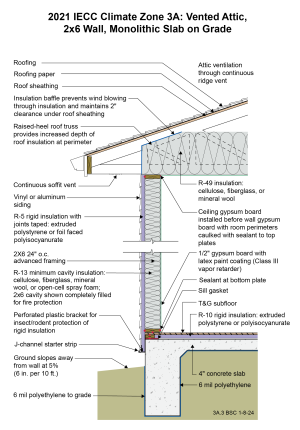Notes
Drawing 3A.3: IECC CZ 3A: Vented Attic, 2x6 Wall, Monolithic Slab on Grade
- If a raised-heel roof truss is used to allow R-38 attic insulation over the full width of the exterior wall, then R-38 can be used throughout the attic rather than R-49. See Section R402.2.1 of the 2021 IECC.
- The rigid foam on the exterior of the wall is not necessary to meet energy efficiency code or to control vapor. It allows construction without using structural sheathing: alternative methods of wall bracing are used instead, and the rigid foam provides a backstop for the cavity insulation as well as some structural support to the siding. Many contractors have found this to be a more economical approach. It is possible to simply use well-installed house wrap instead of the rigid foam, but this would require siding that can span between studs without intermediate backing. Another option for this wall would simply be to use structural sheathing (OSB or plywood) in place of the rigid foam, with house wrap on the exterior of the sheathing.
- The wall is framed with 2x6 24” o.c. advanced framing as it uses less board footage (volume of wood framing) than standard 2x4 16” o.c. framing and therefore is less expensive in material cost. It is also less expensive in labor (25% fewer framing members) and is faster to assemble. Although the code allows for 2x4 framing and lower R-value cavity insulation, the use of advanced framing and the associated cost savings more than offset the increase in the cost of cavity insulation (this of course depends on relative price fluctuations in labor and materials).
- Although the minimum R-value of the insulation in this wall is R-13 per IECC, fire code may require the entire cavity to be filled, likely resulting in a higher R-value for a 2x6 wall.
- The plastic L-bracket at the bottom of the above-grade wall should be perforated to facilitate drainage.
- A class III vapor retarder (latex paint) is used on the interior surface of the walls and ceiling instead of a vapor barrier. This allows drying to the interior. Avoid vinyl wallpaper and oil-based paint or coatings in Climate Zone 3. These wall coverings are vapor impermeable and increase the risk of condensation within the wall.
- In high-risk termite regions, installing rigid insulation on the top of the concrete slab prevents migration of termites through perimeter insulation.
- The entire monolithic concrete slab should have a polyethylene vapor barrier wrapping the underside of the slab and footing to control capillary uptake. The polyethylene should extend upward from the bottom of the footing to grade on the exterior.
